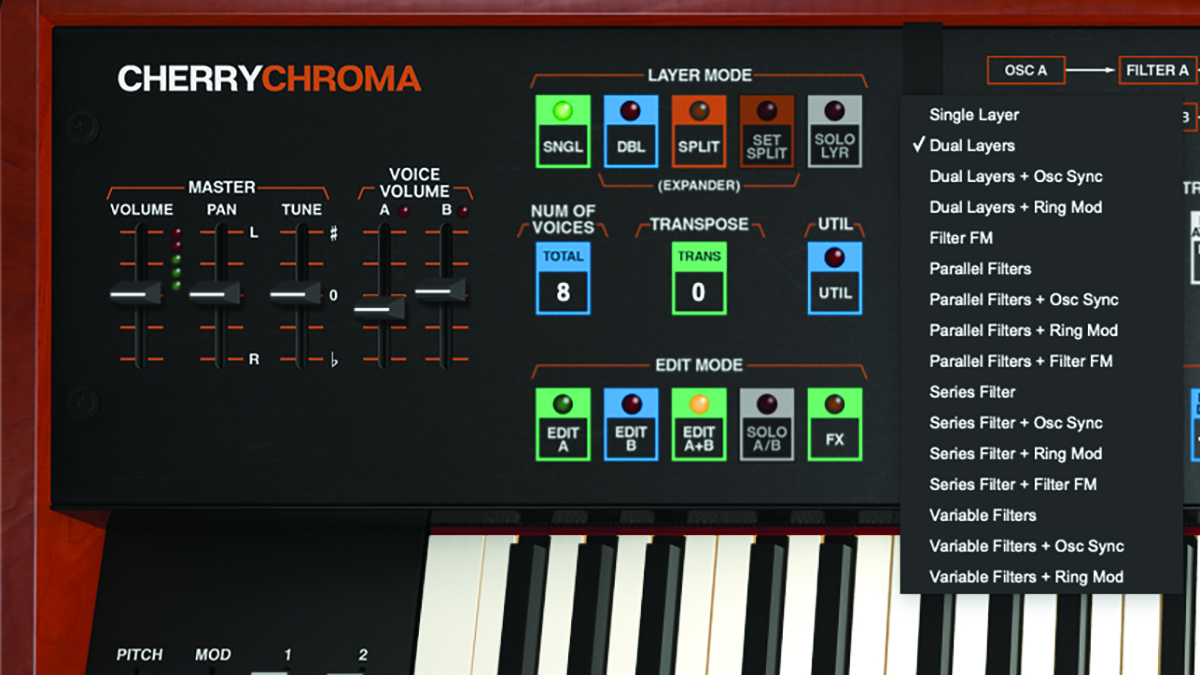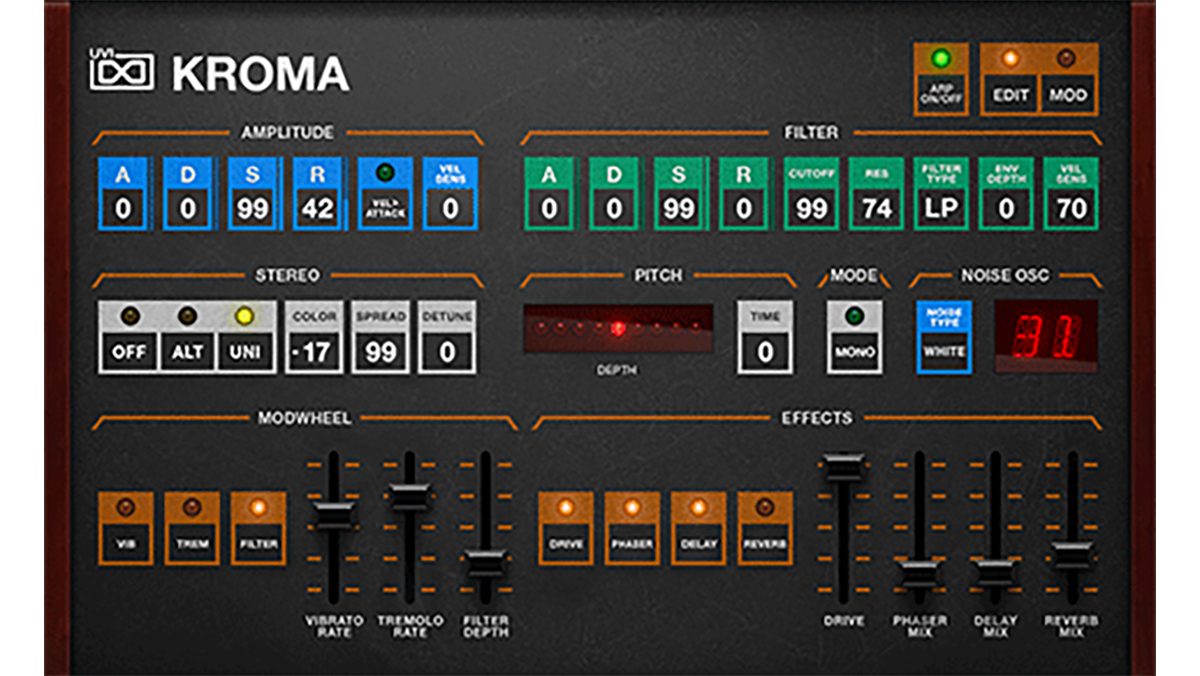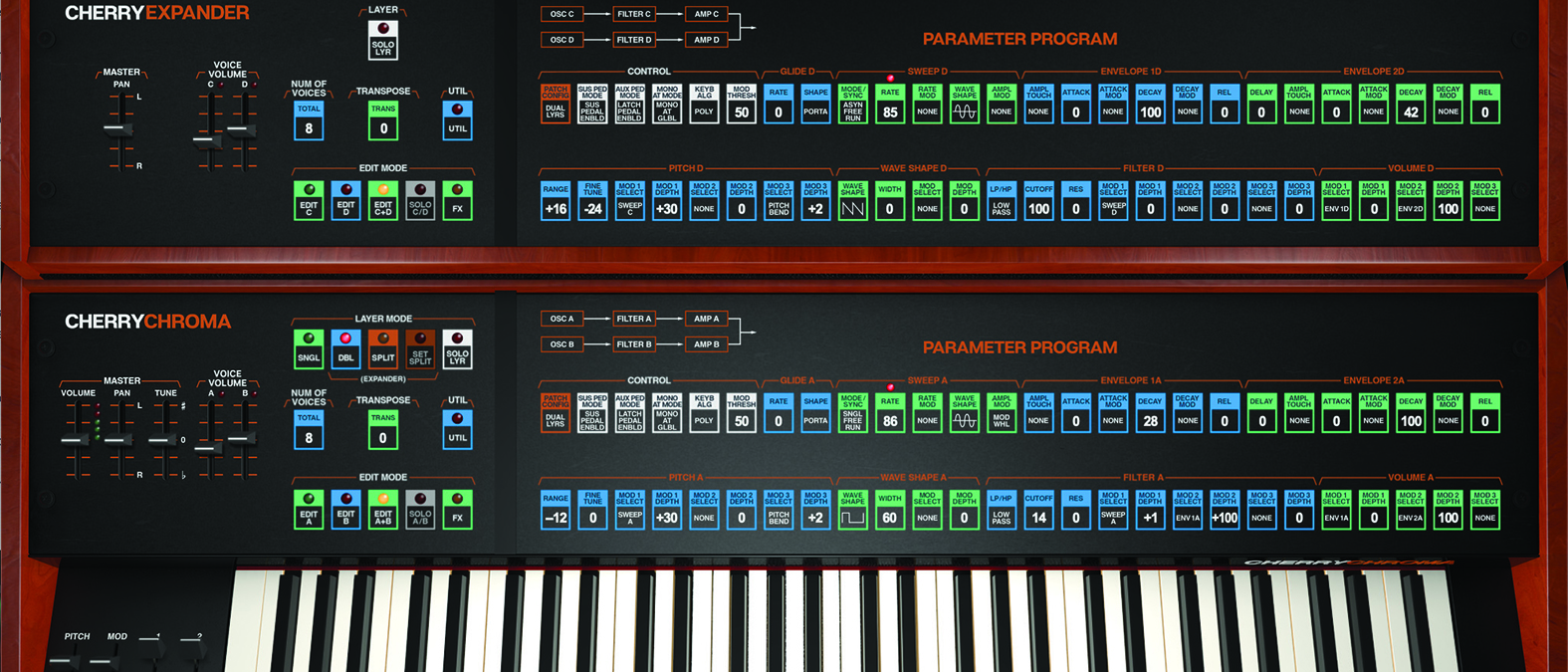MusicRadar Verdict
A true classic, reproduced to a very high standard. Its versatility in use, coupled with huge levels of programmability, make Chroma something of a must-have.
Pros
- +
Incredibly versatile synthesizer.
- +
Includes a range of Sync, FM and Ring modulation capabilities.
- +
Expander included for double the sonic possibilities.
Cons
- -
It’ll take some learning!
MusicRadar's got your back
Cherry Audio Chroma: What is it?
It’s been difficult to ignore the incredible rise of Cherry Audio recently, through its exacting reinterpretations of seminal classics from the vintage synth and drum machine back catalogue, coupled with some new and exciting designs, too. With price tags starting as low as zero, it’s on a charge to bring affordable, amazing-sounding plugins to the masses.
What makes Chroma particularly interesting, is that the Rhodes Chroma is apparently one of the most requested synths for recreation, which is just as well, because an original vintage model could easily set you back five figures.
So, what is the Chroma, and why is it of such interest? The Chroma began development under the watchful eye of Alan Robert Pearlman. You might know his company better as ARP, the producers of legendary synths such as the Odyssey and 2500 or 2600. Research began in the late ’70s, on a radical new design of analogue synthesizer, moving away from the expense of a fader-laden panel, in favour of press buttons, a data entry fader and microprocessor control.
Regrettably, ARP filed for bankruptcy in 1981, leaving the design in the wilderness. Thankfully it was picked up by CBS and put into production in 1982 through their Rhodes division.

Cherry Audio Chroma: Performance and verdict
Chroma is, in essence, a subtractive synth armed with two oscillators per voice and up to 16 voices.

• UVI Kroma
A sampled incarnation of the Chroma, which operates within UVI’s Workstation or Falcon plugins.
• Vintage Synth Samples Rhodes Chroma Vol 1 & 2
An affordable selection of sounds for your own sample software.
Cherry Audio has included the expander, which doubles the oscillator count to four per voice. These voices and oscillators can be assigned to a number of routings, but for the most part, the expander and main unit operate as separate voices, meaning that you can get very creative. Layers and splits are de rigueur although you have to keep your wits about you, as you can easily find yourself editing the wrong layer. A Solo Layer button provides a useful shortcut to narrowing down the editing process.
Talking of which, Cherry Audio has engineered a shortcut to programming. Unlike the original, you do not have to select a parameter before adjusting a value fader. You merely need to click on your chosen parameter and select your required setting from a drop-down, or click and drag to assign a value. A number of edit modes are available, so you can work on individual layers or sum them together, to apply parameters universally.
Want all the hottest music and gear news, reviews, deals, features and more, direct to your inbox? Sign up here.

Oscillator routing and shaping
The Chroma is equipped with a number of features that bring versatility to its tonal colour. This starts at the oscillator level, where you can choose to vary your chosen wave’s shape. This is restricted to saw, pulse, white and pink noise, but the capacity to blend and modulate these waves opens up a large palette.
The routing of oscillators and filters is handled by the routing section, located on the upper section of the panel, where you can dictate how you want the oscillators to be deployed. This begins with the simplicity of a single layer, through to Filter FM and Ring Modulation, all of which can act as the genesis to more resonant and metallic tones. Add this to the second layer, available through the use of the expander, and you can create some interesting colours, each with their own envelope and filter settings.
All the finer details
Chroma has been in the works for over 18 months, and Cherry Audio has applied some painstakingly accurate analysis to every nuance emitted from the synth. We did not have a vintage unit for comparison, but past reincarnation of other models have revealed exacting detail across all parameters and circuits, at both the numeric and sonic level.
As a sum of parts, we must say, it sounds utterly superb. The emanating filter colours are really beautiful and with access to multiple layers, we could very much extend the possibilities of unravelling interest, through different modulation settings applied at the layer level. The output has depth and detail, resulting in some very beefy basses, interesting pads, percussion and searing leads.
A perfectly-framed synth that should inspire when working in all genres
As a softsynth, Chroma is likely to require a degree of exploration, in order to grasp its inner workings, but as we discovered, you quickly garner confidence and start building patches that can sound enormous, with the odd happy accident thrown in along the way. If you’re less confident in the patch-building approach, the 700 included patches are organised in menus, and present an impressive picture-book of what can be achieved with practice. Chroma is a perfectly-framed synth that should inspire when working in all genres of DAW-based production.
MusicRadar verdict: A true classic, reproduced to a very high standard. Its versatility in use, coupled with huge levels of programmability, make Chroma something of a must-have.
Cherry Audio Chroma: The web says
"The new Cherry Audio Chroma impressed me with its features, quality, and presets — one of the best Cherry plugins I’ve tested so far."
Synth Anatomy
Cherry Audio Chroma: Hands-on demos
Cherry Audio
Alex Reid

CatSynth TV
Andrew G Dugros
Cherry Audio Chroma: Specifications
- macOS 10.13 or above. 64-bit required. Intel or Apple Silicon processor. 3.4GHz Quad-Core or Apple Silicon CPU with 8GB of RAM recommended.
- Windows 7 or above. 64-bit required. 3.4GHz Quad-Core computer with 8GB of RAM recommended.
- Available in AU, VST, VST3, AAX, and standalone formats.
- CONTACT: Cherry Audio
Roland Schmidt is a professional programmer, sound designer and producer, who has worked in collaboration with a number of successful production teams over the last 25 years. He can also be found delivering regular and key-note lectures on the use of hardware/software synthesisers and production, at various higher educational institutions throughout the UK




